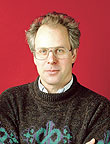The bedrock of collaboration
Ken Long, professor at Imperial College London and chair of the International Design Study for the Neutrino Factory, wrote this guest column.
 |
| Ken Long |
When Fermilab physicist Steve Geer proposed to establish a joint Fermilab/Imperial College London fellowship program for muon beam R&D, I knew that the first stone had been laid in the foundation of an exciting, long-term partnership. The program, now three years old, allows us to recruit and train outstanding individuals, develop solutions to the key technological issues that underpin a neutrino factory and muon collider, and establish a firm basis for future collaboration.
To date we have recruited two fellows into our program. Ajit Kurup and Leo Jenner work on what are arguably two of the most challenging issues that face the muon facilities of the future: the production of an intense, pulsed proton beam to produce muons and the cooling of muons to obtain a good quality muon beam.
Kurup has made significant contributions to the MuCool program at Fermilab, which--under the leadership of Alan Bross--seeks to improve muon cooling systems by giving physicists a better understanding of the performance of accelerating cavities operating in intense magnetic fields, a critical issue for both a muon collider and a neutrino factory.
Jenner works on the design of a proton accelerator capable of delivering a beam power of 2-4 MW at about 10 GeV. The goal is to design an accelerator that can deliver one to three bunches of protons 50 times per second, each bunch lasting a few nanoseconds. Jenner's design work applies to both the proposed Project X linac at Fermilab and the proposed megawatt upgrade of the ISIS pulsed neutron spallation source at the Rutherford Appleton Laboratory in the United Kingdom.
I believe the joint Fermilab/Imperial College London fellowship program is a fantastic opportunity for our fellows as well as our institutions. This kind of collaboration is the bedrock on which a neutrino factory and muon collider may one day be built.
Editor's note: Ken Long also wrote the short article on the physics potential of muons, featured in the center column of today's issue.
|